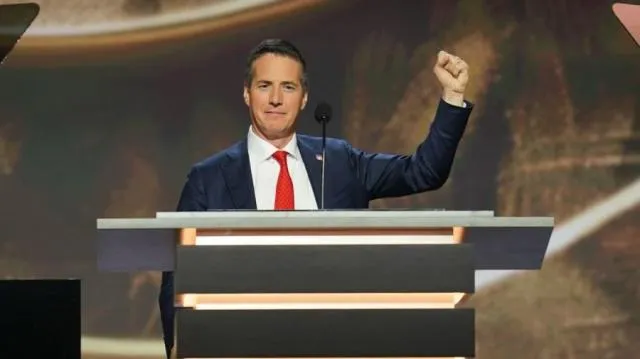
Sebastian Stan revealed he saved hundreds of videos of Donald Trump in order to master his physicality.
Sebastian Stan, renowned for his role as Bucky Barnes (Winter Soldier) in the Marvel Cinematic Universe, recently opened up about the challenges and motivations he faced when considering the portrayal of former President Donald Trump. In a candid interview, Stan shared that numerous people advised him against taking on the role, expressing concerns about the safety and public perception surrounding such a controversial figure.
The Decision to Play Trump
When the opportunity to play Trump arose, Stan was met with a mixture of excitement and apprehension. “There were a lot of voices in my head,” he admitted. “Some people told me not to do it. Some said I didn’t look like him. Others warned that it wouldn’t be safe. And there were those who said I shouldn’t try to alienate half the country.” These varied opinions only fueled his desire to explore the role further.
Despite the warnings, Stan found himself intrigued by the complexities of Trump’s character and the significance of his actions during his presidency. “I think portraying such a polarizing figure is an opportunity to delve into the nuances of leadership, influence, and the consequences of one's decisions,” he explained. This complexity is what drew Stan to the role, compelling him to navigate the challenges that come with such a high-profile character.
Playing Trump is undoubtedly a daunting task, given the strong feelings and divisive opinions surrounding him. Stan acknowledged the weight of responsibility that comes with embodying someone who has had a profound impact on American society. “It’s not just about impersonation,” he noted. “It’s about understanding the psychological and emotional layers that come with that kind of power.” Stan’s commitment to authenticity led him to immerse himself in research, studying Trump’s speeches, mannerisms, and public persona. He aimed to capture not only the physicality of Trump but also the intricacies of his character. “I wanted to portray the man behind the headlines, to explore what drives someone to seek power at that level,” he said.
Navigating Public Perception
One of the significant concerns for Stan was how audiences would react to his portrayal. With such a divided political landscape, he understood that his performance could evoke strong reactions. “I was aware that no matter how I approached the role, there would be those who loved it and those who hated it,” he reflected.
Despite this awareness, Stan felt that taking on the role could spark important conversations about leadership, responsibility, and the impact of political actions. “Art has a way of reflecting society and prompting discussions,” he stated. “I believe that this role could serve as a vehicle for deeper conversations about the state of our nation.”
Throughout his journey of preparing for the role, Stan received support from fellow actors and colleagues who encouraged him to embrace the challenge. “Some of my peers reminded me that playing complex characters is part of what we do as actors,” he shared. “They urged me to explore the role fully, to not shy away from the discomfort.” This encouragement helped Stan reaffirm his commitment to the project. “It became clear to me that if I was going to do this, I had to give it my all,” he said. “I couldn’t let fear dictate my choices.”

Maria Bakalova and Sebastian Stan in "The Apprentice"
The Role of Empathy in Acting
Stan emphasized the importance of empathy when taking on challenging roles, especially those involving controversial figures. “As actors, we have to step into someone else’s shoes, even if we disagree with their actions or beliefs,” he explained. “It’s about understanding their motivations and the context in which they operate.”
This empathetic approach not only enriched Stan’s performance but also allowed him to engage in conversations about the themes of power, ethics, and the consequences of leadership. “By exploring Trump’s character, I hope to shed light on the complexities of authority and the moral dilemmas that leaders face,” he remarked.
As the project moves forward, Stan is aware that both fans and critics will closely scrutinize his portrayal. “I understand that there will be a lot of discussions, debates, and potentially some backlash,” he admitted. However, he remains confident that his performance will resonate with audiences who appreciate the artistic exploration of complex characters.
“I believe in the power of storytelling to challenge perspectives,” Stan stated. “Even if my portrayal is polarizing, I hope it encourages people to reflect on their beliefs and engage in meaningful discussions.”
Future Projects and Aspirations
While Stan is focused on his portrayal of Trump, he also has other projects in the pipeline. He expressed excitement about exploring a range of characters that push his artistic boundaries. “I love taking on roles that challenge me, that force me to grow as an actor,” he shared.
Stan sees his work as an opportunity to contribute to the broader narrative of society, using his platform to spark conversations about critical issues. “I hope to continue exploring complex themes and characters that resonate with people,” he said.
Sebastian Stan’s journey to portray Donald Trump is marked by challenges, motivations, and a commitment to authenticity. While concerns about safety and public perception loom, Stan is determined to navigate these complexities and bring depth to the role. By embracing empathy and understanding, he aims to create a performance that encourages dialogue about leadership and the moral dilemmas that accompany it. As the project unfolds, audiences can anticipate a nuanced portrayal that reflects the intricacies of a controversial figure. Stan’s dedication to exploring the human experience, even in the face of adversity, showcases the power of storytelling in shaping societal conversations. With each performance, he continues to demonstrate that art can be a catalyst for reflection and growth, even when tackling the most divisive topics.



-1728359867-q80.webp)